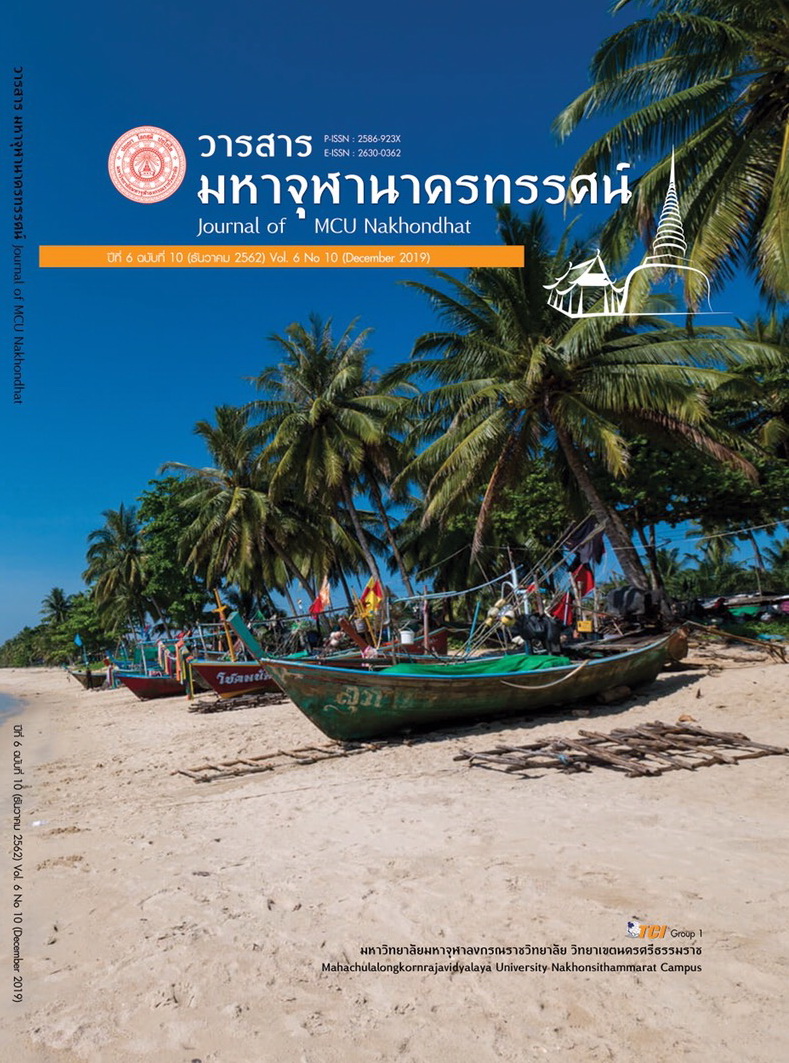THE MODEL AND PROCESS OF BUDDHIST KNOWLEDGE MANAGEMENT OF THE DHAMMA PRACTICE CENTER
Main Article Content
Abstract
This research the objectives are 1) To study the concept theories of knowledge management 2) To analyze the knowledge management in Buddhism 3) To present the model of knowledge management Integrative Buddhism of the Dhamma Practice Center. This research is qualitative research and Participant Observation.
Results showed that:
- The research found that there are two types of knowledge theory: Explicit knowledge and Tacit knowledge. The knowledge management model based on the concept of Tuna Model as a Fish. There are three parts of a Fish.
The Fish head, namely, the target, vision, or direct. The Fish body is knowledge sharing. The tail Fish is a collection of Knowledge. The knowledge management has two goals : Organizational development and Work development. By the refining of society, extracting knowledge from identity, integration of knowledge and seal the knowledge in their own in the spiral pattern of new knowledge generation process. - There are two types of knowledge management in Buddhism: knowledge of Lokiya as for general as Explicit knowledge and knowledge of Lokuttara as Tacit knowledge. The model is the vision of knowledge management aims to maintain the Doctrine and Discipline not to lose have sharing and learn how to assembly of monks in the Sangha. And stored in the Organization’s knowledge store as a meeting of Buddhist monks to collect the teaching as a category develop in to a Tipitaka.
- The model and process of knowledge management integrative Buddhism of the Dhamma Practice Center Autonomy are composed of 4 components: 1) Objective 2) Content 3) knowledge management process, and 4) Results
Article Details
How to Cite
(สิงห์แจ่ม) พ. อ., . พ., & ปันธิยะ พ. (2020). THE MODEL AND PROCESS OF BUDDHIST KNOWLEDGE MANAGEMENT OF THE DHAMMA PRACTICE CENTER. Journal of MCU Nakhondhat, 6(10), 5560–5575. retrieved from https://so03.tci-thaijo.org/index.php/JMND/article/view/224678
Section
Research Articles
References
ปรียารัตน์ ใจเนตร. (2562). รูปแบบการบริหารงานบุคคลเชิงพุทธบูรณาการของสถานศึกษาขั้นพื้นฐาน. ใน ดุษฎีนิพนธ์ปรัชญาดุษฎีบัณฑิต สาขาการบริหารการศึกษา. มหาวิทยาลัยเชียงใหม่.
พระธรรมปิฎก (ป.อ. ปยุตฺโต). (2538). พุทธธรรมฉบับปรับปรุงขยายความ. กรุงเทพมหานคร: โรงพิมพ์มหาจุฬาลงกรณราชวิทยาลัย.
มงคลชัย วิริยะกิจ. (2554). องค์กรแห่งการเรียนรู้และการจัดการความรู้. กรุงเทพมหานคร: สำนักพิมพ์ส่องศยาม.
มหาจุฬาลงกรณราชวิทยาลัย. (2539). พระไตรปิฎกภาษาไทย ฉบับมหาจุฬาลงกรณราชวิทยาลัย. กรุงเทพมหานคร: โรงพิมพ์มหาจุฬาลงกรณราชวิทยาลัย.
สมชาย นำประเสริฐชัย. (2558). การจัดการความรู้. กรุงเทพมหานคร: บริษัท ซีเอ็ดยูเคชั่น จำกัด (มหาชน).
สุวรรณ เหรียญเสาวภาคย์ และคณะ. (2548). การจัดการความรู้. กรุงเทพมหานคร: กลุ่มพัฒนาระบบบริหารสำนักงานคณะกรรมการพัฒนาระบบราชการ (ก.พ.ร.).
เอื้อมอร ชลวร. (2554). การจัดการความรู้เชิงพุทธบูรณาการ. ใน ดุษฎีนิพนธ์พุทธศาสตรดุษฎีบัณฑิต สาขาวิชาพระพุทธศาสนา. มหาจุฬาลงกรณราชวิทยาลัย.
Takeuchi Hirotaka and Nonaka Ikujiro. (2004). Hitotsubashi on Knowkedge Management. Singapore : John Wiley & Sons (Asia) Pte Ltd.
พระธรรมปิฎก (ป.อ. ปยุตฺโต). (2538). พุทธธรรมฉบับปรับปรุงขยายความ. กรุงเทพมหานคร: โรงพิมพ์มหาจุฬาลงกรณราชวิทยาลัย.
มงคลชัย วิริยะกิจ. (2554). องค์กรแห่งการเรียนรู้และการจัดการความรู้. กรุงเทพมหานคร: สำนักพิมพ์ส่องศยาม.
มหาจุฬาลงกรณราชวิทยาลัย. (2539). พระไตรปิฎกภาษาไทย ฉบับมหาจุฬาลงกรณราชวิทยาลัย. กรุงเทพมหานคร: โรงพิมพ์มหาจุฬาลงกรณราชวิทยาลัย.
สมชาย นำประเสริฐชัย. (2558). การจัดการความรู้. กรุงเทพมหานคร: บริษัท ซีเอ็ดยูเคชั่น จำกัด (มหาชน).
สุวรรณ เหรียญเสาวภาคย์ และคณะ. (2548). การจัดการความรู้. กรุงเทพมหานคร: กลุ่มพัฒนาระบบบริหารสำนักงานคณะกรรมการพัฒนาระบบราชการ (ก.พ.ร.).
เอื้อมอร ชลวร. (2554). การจัดการความรู้เชิงพุทธบูรณาการ. ใน ดุษฎีนิพนธ์พุทธศาสตรดุษฎีบัณฑิต สาขาวิชาพระพุทธศาสนา. มหาจุฬาลงกรณราชวิทยาลัย.
Takeuchi Hirotaka and Nonaka Ikujiro. (2004). Hitotsubashi on Knowkedge Management. Singapore : John Wiley & Sons (Asia) Pte Ltd.


